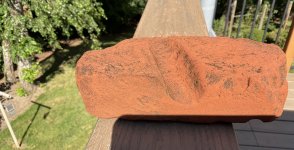Hey sleuths….once again I need your help.
I found this brick in my usual stomping grounds: confluence of rivers near the Columbia River. I have found Salmon fishing, Native American, trapper, military and wharf artifacts here. This brick has been collecting moss in my garden. The measurements indicate it is the standard brick size from 1820 and beyond. I am not an expert, but I believe this brick was hand made (not factory manufactured). It has always perplexed me on why/how the groove was put there. At first I thought it was industrial and had a purpose, maybe for drainage or maybe if placed with another opposite brick it could have held in place a pole/pipe, etc. But upon further inspection, the brick clearly was "worked" on. The groove definitely angles down, like someone was plying force in a downward and outward fashion. If some one wanted to design a utility purpose wouldn’t they have done so during the molding process? It looks like this was used for sharpening and/honing a cylindrical object. Maybe a salmon jigger? The (non modern) age of the brick also means the Native Americans could have used it as well.
Any ideas to the age of the brick…..and the reason it was modified?
I found this brick in my usual stomping grounds: confluence of rivers near the Columbia River. I have found Salmon fishing, Native American, trapper, military and wharf artifacts here. This brick has been collecting moss in my garden. The measurements indicate it is the standard brick size from 1820 and beyond. I am not an expert, but I believe this brick was hand made (not factory manufactured). It has always perplexed me on why/how the groove was put there. At first I thought it was industrial and had a purpose, maybe for drainage or maybe if placed with another opposite brick it could have held in place a pole/pipe, etc. But upon further inspection, the brick clearly was "worked" on. The groove definitely angles down, like someone was plying force in a downward and outward fashion. If some one wanted to design a utility purpose wouldn’t they have done so during the molding process? It looks like this was used for sharpening and/honing a cylindrical object. Maybe a salmon jigger? The (non modern) age of the brick also means the Native Americans could have used it as well.
Any ideas to the age of the brick…..and the reason it was modified?
Attachments
-
 25D4C51C-020C-434C-A7D5-CBB48CA917C4.jpeg665.3 KB · Views: 76
25D4C51C-020C-434C-A7D5-CBB48CA917C4.jpeg665.3 KB · Views: 76 -
 7CDB0645-4421-4C41-8C05-B090FA9F84D8.jpeg347.3 KB · Views: 49
7CDB0645-4421-4C41-8C05-B090FA9F84D8.jpeg347.3 KB · Views: 49 -
 C8682819-5585-49B1-8D21-64FFB6293D00.jpeg1.6 MB · Views: 43
C8682819-5585-49B1-8D21-64FFB6293D00.jpeg1.6 MB · Views: 43 -
 7D62DD1A-3832-40BF-9846-72DECC7F9395.jpeg1.3 MB · Views: 49
7D62DD1A-3832-40BF-9846-72DECC7F9395.jpeg1.3 MB · Views: 49 -
 13EF2F83-5786-476B-8152-28B0D61793EF.jpeg1.9 MB · Views: 43
13EF2F83-5786-476B-8152-28B0D61793EF.jpeg1.9 MB · Views: 43 -
 40F5AE83-09AC-4602-BC06-99DC76D0160A.jpeg1.3 MB · Views: 38
40F5AE83-09AC-4602-BC06-99DC76D0160A.jpeg1.3 MB · Views: 38 -
 374A0F99-CCB6-4BCD-9B18-83840CEBE40E.jpeg1.2 MB · Views: 45
374A0F99-CCB6-4BCD-9B18-83840CEBE40E.jpeg1.2 MB · Views: 45
Last edited:








